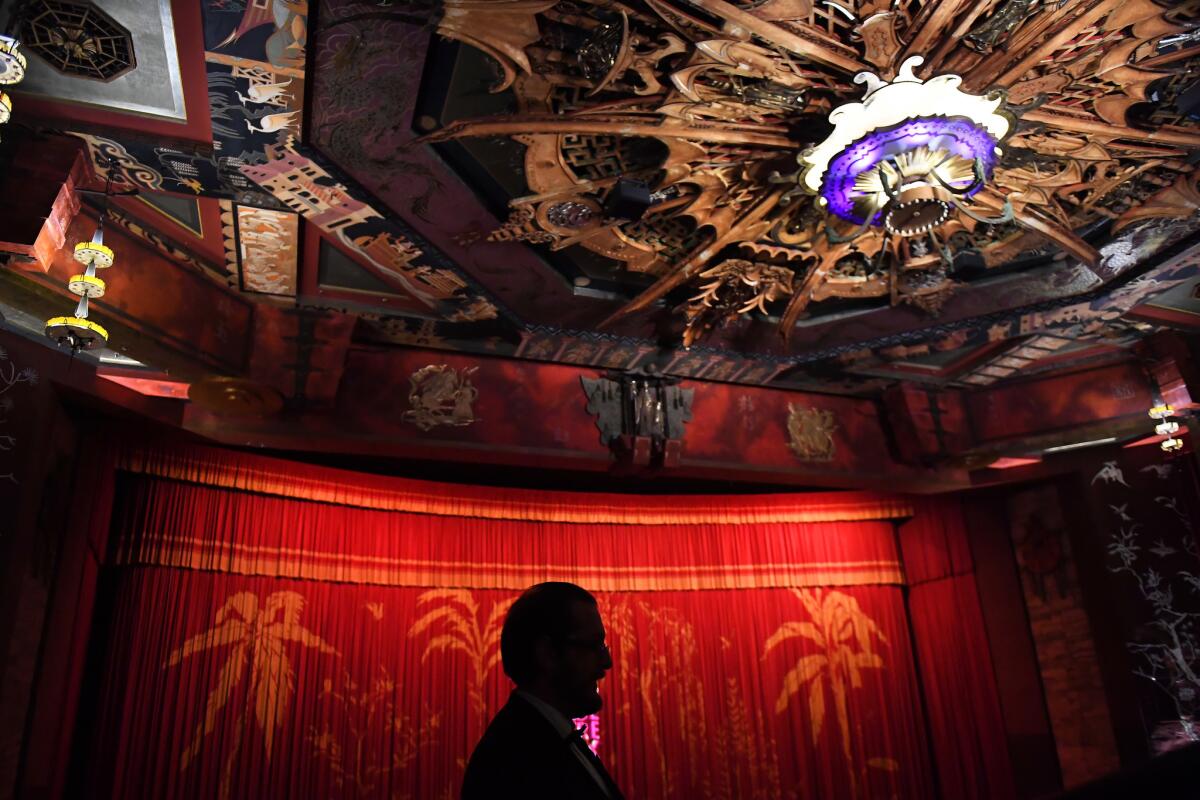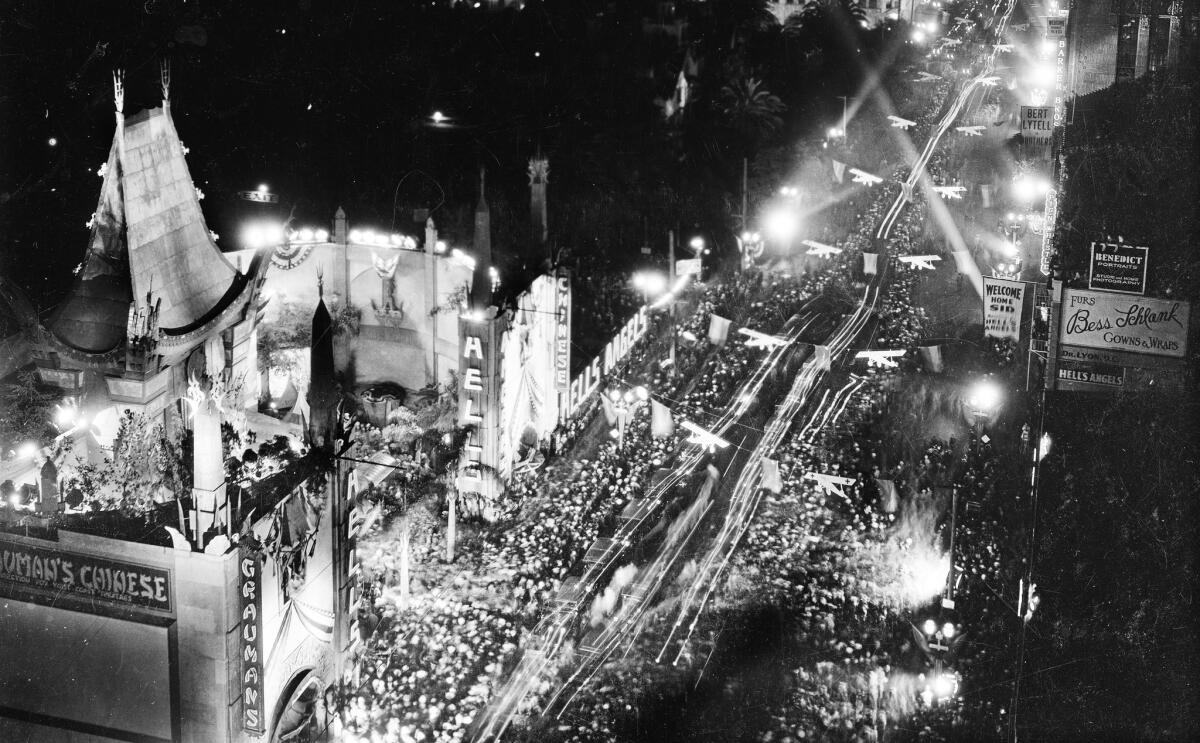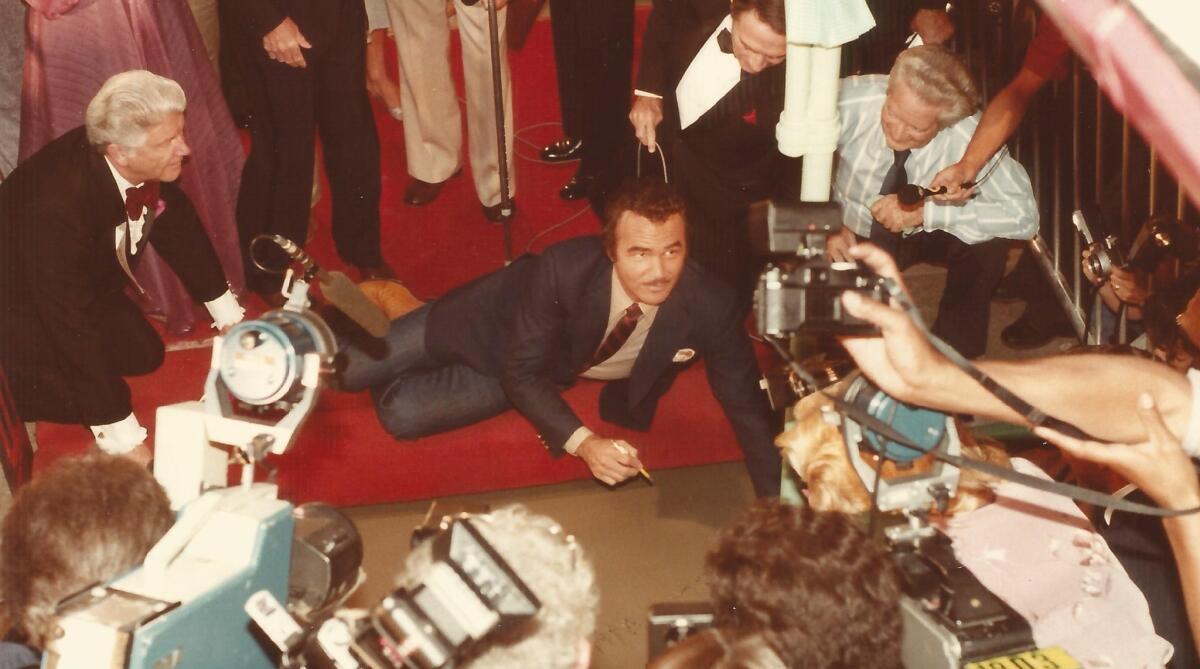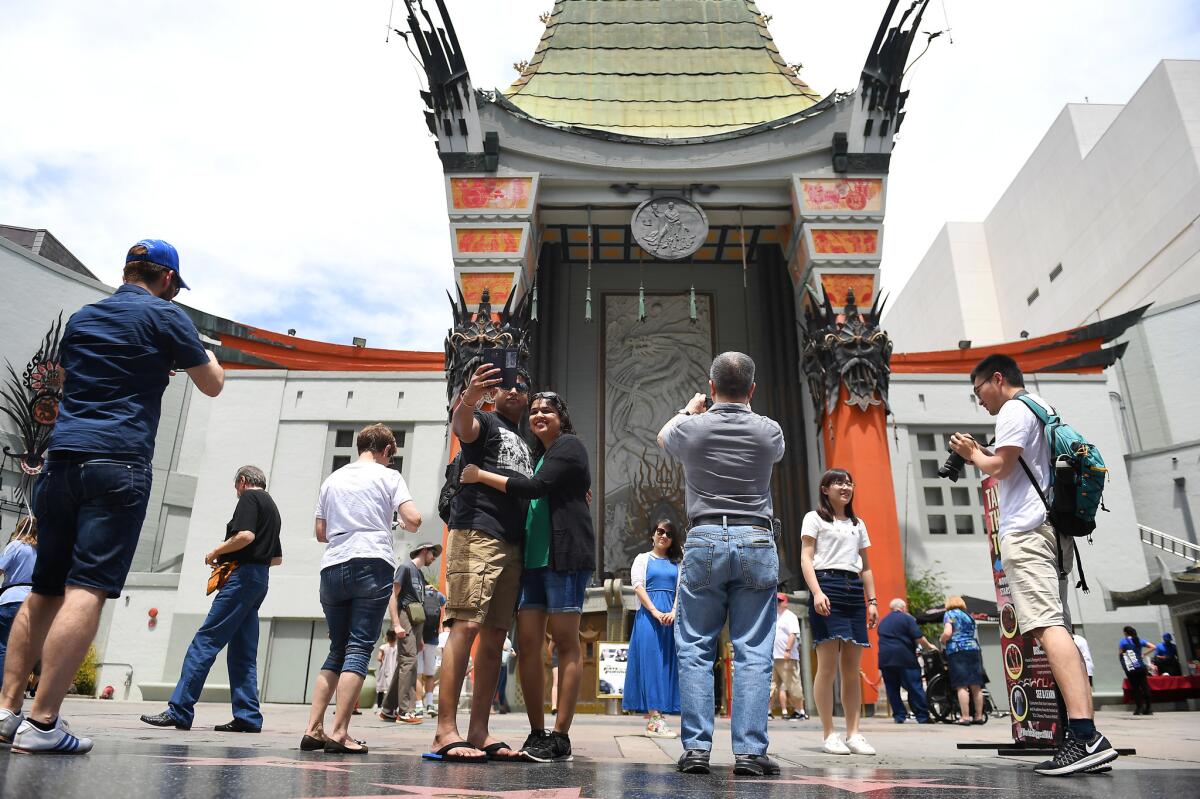From Grauman’s to TCL: 90 years of the Chinese Theatre
It opened on Hollywood Boulevard 90 years ago in spectacular fashion with the lavish premiere of Cecil B. DeMille’s religious epic “The King of Kings.”
Master showman Sid Grauman had built other movie palaces — the Million Dollar Theatre in downtown L.A. and the Egyptian Theatre in Hollywood — but the theater he named Grauman’s Chinese was the culmination of his dreams.
In the years since its May 16 unveiling, the Chinese has had various owners and renovations; the most recent transformed it into the TCL Chinese Theatre Imax. Under any name, it is perhaps the most famous movie theater in the world. An estimated 5 million people a year visit its signature Forecourt of the Stars, snapping photos (and now selfies) of handprints and footprints left in cement by stars ranging from Mary Pickford to the human and robotic leads of “Star Wars” (whose likenesses have been known to prowl the adjacent Hollywood Boulevard).
Grauman, who co-owned the theater with his partners Howard Schenck, Pickford and Fairbanks, sold his shares to Fox West Coast Theatres in 1929 but continued to work as managing director of the theater until he died in 1950.
To see how the new nonagenarian is holding up, we took a tour with Levi Tinker, who has been a guide there for 17 years and currently manages the theater.
Here are some things we discovered:

Movie mansion to movie theater
There’s a plaque on the front of the building that says it’s dedicated to Francis X. Bushman. That’s because the silent-screen star (“Ben-Hur”) originally lived in a mansion where the TCL Chinese Theatre now stands. “Bushman gave Sid permission to build the theater on that land,” said Tinker, noting that Grauman leased the land from Bushman.
The theater cost $2.1 million to build. At the entrance, two massive coral-red columns, topped by wrought-iron masks, appear to hold up the bronze roof. A 30-foot-high dragon, carved from stone, is located between the columns. Two heaven dogs from China stand guard.
Artists and artisans
A number of Chinese artisans were hired to work on the theater. “A lot of the statuary figures were done by [poet and film director] Moon Quon,” Tinker said.
The massive starburst medallion that decorates the theater’s ceiling is three separate pieces of wood brought from China. The paintings surrounding the medallion were created in 1927 from stencils by John Beckman, one of the theater’s chief designers, and have never been touched up.
Chinese Theatre turns 90
Everything you need to know about the Chinese Theatre's celebrity cement handprints
“From what I’ve been told,” Tinker said, “[they tell] the story of a young boy who becomes a prince. He’s right in there fighting this dragon.”
“What’s also cool, and it’s kind of hard to see,” Tinker said, “are areas [around the artwork] where the names of the people who were involved in the theater are hidden in Chinese.” He added that there are also phrases written in Chinese hidden through the auditorium and lobby.
Speaking of cool, the Chinese was the first commercial movie theater with air conditioning. The pillars that are on each side wall, which were imported from China, are not only decorative, they also house the vents for air conditioning and heating systems.
The artwork of trees and leaves between the pillars was painted by bandleader Xavier Cugat, who also worked as a caricaturist and cartoonist at the L.A. Times.
The elaborate Chinese murals decorating the lobby were painted by Chinese American actor Keye Luke, who played the No. 1 son in the Charlie Chan movies, Kato in “The Green Hornet” serials and Master Po on the TV series “Kung Fu."
“At this point, he was a stage actor and also a matte painter too,” said Tinker. “The press book for [the original] ‘King Kong’ was also done by Keye Luke.”

A real theater, so no popcorn
There was no concession stand in the theater until the 1930s because, Tinker says, Grauman wanted the audience to have a theatrical experience. “He felt that when you come inside, you would be transported off to a different time and different place,” Tinker said. “You’d see Grauman’s prologue before most of the movies that would play inside that would tie thematically to the film that was playing.”
He felt that when you come inside, you would be transported off to a different time and different place.
— Levi Tinker, the theater's general manager, about Sid Grauman
The prologues were elaborate affairs. Noted Tinker: “There was a 65-piece orchestra, musical performers on stage and a lot of times they’d actually have someone from the production involved. Like for ‘The Gaucho,’ the second movie to play here, for the first couple of weeks Douglas Fairbanks played the Gaucho on stage as well as in the movie itself."
Grauman produced the shows until 1929 when he retired. Howard Hughes asked him back in 1930 to do the prologue for his World War I epic “Hell’s Angels.” And when he returned to the theater in 1931 as managing director, he did stage shows until 1939.
Premieres
Movie premieres at the Chinese have always been star-studded affairs. But even such contemporary premieres as 2015’s “Star Wars: The Force Awakens,” which shut down a section of Hollywood Boulevard, didn't hold a candle to the premiere of “Hell’s Angels."
“The stage show for opening night was not inside the theater, it was outside in the night sky,” Tinker said. “They had World War I biplanes in a mock dogfight. They had fireworks going off and had people parachuting. They had people lined up a mile and half down the road past Vine Street watching the limos come down. They had planes flying down there too. If you look at the pictures and everything, it’s absolutely incredible.”
Footprints through time
The two oldest handprints and footprints are in the center of the forecourt. Douglas Fairbanks and Mary Pickford began the tradition in late April 1927 but dated their imprints for the theater’s opening day.

Olympic ice skating movie star Sonja Henie included her skate blades in the cement. Director Raoul Walsh made a fist in the cement. Tinker explains: “Sid asked him what is that? He said his heart, so he left his heart at the theater.”
And Marilyn Monroe left an earring when she and Jane Russell did their ceremony for “Gentlemen Prefer Blondes” in 1953.
“She wanted to put down a diamond, but the management said if you put a diamond down there, someone is going to steal it,” noted Tinker. “They suggested one of the earrings she was wearing. She put one of them in cement. A few days later someone came along and tried to pull it out, but it had already set at that point. But the top broke off, so the back of the earring is still down there.”
The only handprints and footprints removed from the forecourt belonged to Edmond Purdom, who starred in the 1954 film “The Egyptian” and a few others before he went to Europe.
“People complained that he got it basically for his first starring role,” Tinker said. “They took it out very quietly. No one knows [where it went]. I looked.”
Thoroughly modern movie theater
The Chinese Theatre and the TCL Chinese Six at Hollywood & Highland were bought by a group of investors in 2011 that included producer Donald Kushner. His daughter, producer Alwyn Hight Kushner, who is part of the group, is also the president of the theater.
She sees a lot in common between Grauman and the new owners. “They are kind of following in the footsteps of Grauman’s, all showmen in their own right.”

In 2013, the Chinese electronics manufacturer TCL — The Creative Life — invested in a 10-year naming rights partnership. “The influx of investment has really helped us invest in the theater,” she said.
Though they are bringing the theaters into the 21st century, they are being respectful of the extraordinary heritage of the Chinese.
“When you look at the history and the legacy of the theater, it’s about being cutting edge,” Kushner said. “That’s what Sid Grauman did. He was ahead of his time.”
Only good movies
Get the Indie Focus newsletter, Mark Olsen's weekly guide to the world of cinema.
You may occasionally receive promotional content from the Los Angeles Times.








